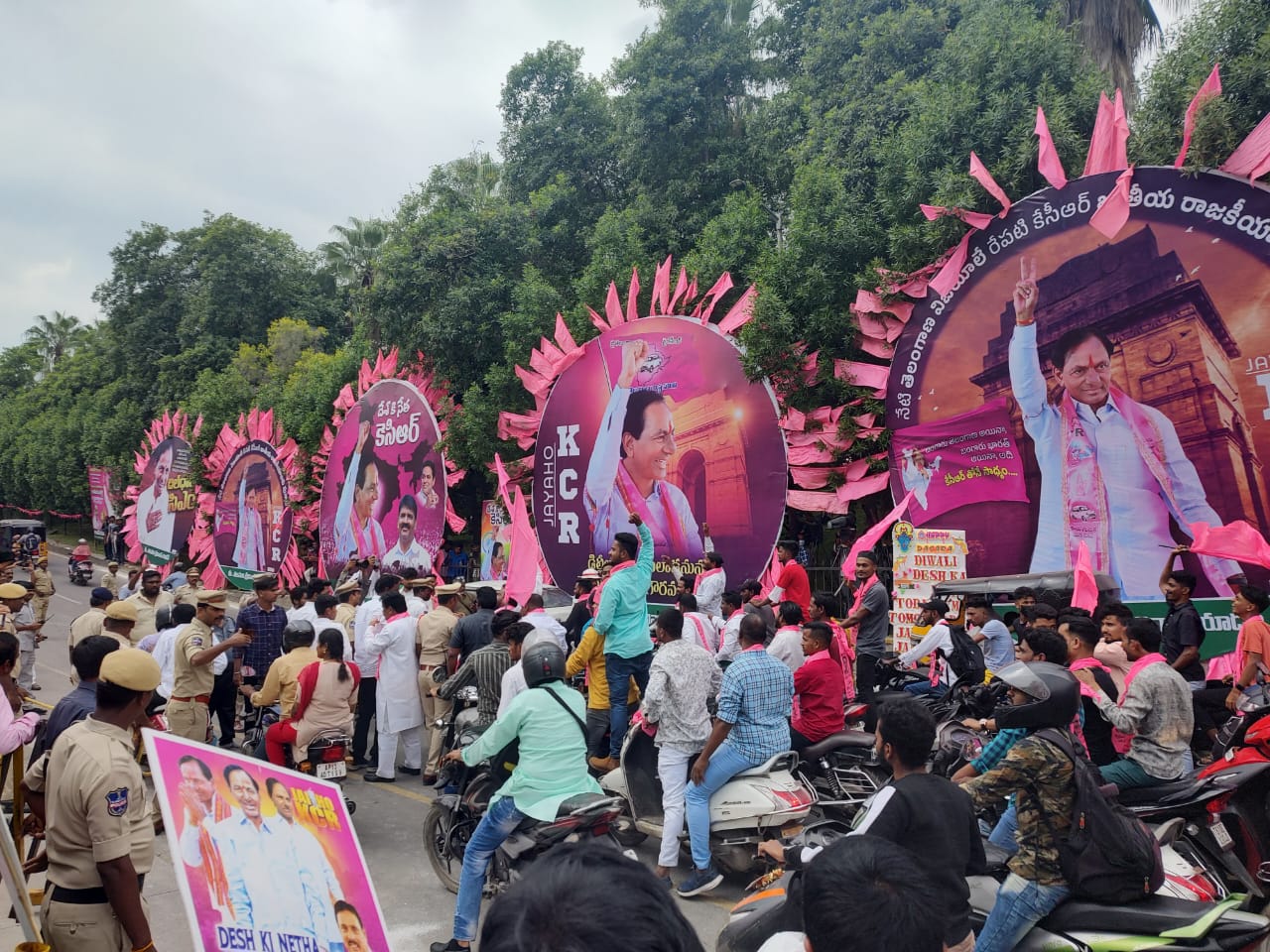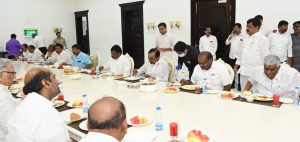K Chandrashekar Rao is transforming the Telangana Rashtra Samiti into the Bharat Rashtra Samiti, his national front. But it takes more than a name change to become a national party.

Massive hoardings hailing Telangana Chief Minister and TRS Chief K CHandrashekhar Rao in Hyderabad on Wednesday. (Ajay Tomar/South First)
Telangana Chief Minister K Chandrashekar Rao is scaling up his party, the Telangana Rashtra Samiti, into the Bharat Rashtra Samiti.
Keen on opening up a pan-India approach, the BRS hopes to take on the Bharatiya Janata Party (BJP) and the Congress through a national front propelled by regional parties.
While TRS leaders aggressively push the BRS to be a national party and will approach the Election Commission of India (ECI) to allow a name change and recognition as a national party, it is easier said than done.

JDS’ HD Kumaraswamy and VCK’s Thol Thirumavalavan with Telangana CM K Chandrashekhar Rao on Wednesday. (Ajay Tomar/South First)
Leaders of other regional parties, like the Janata Dal (Secular) or JD(S) in Karnataka and the Viduthalai Chiruthaigal Katchi (VCK) in Tamil Nadu, were part of the TRS general body meeting on Wednesday.
Ahead of KCR announcing his national front, former Karnataka chief minister HD Kumaraswamy, accompanied by a host of JD(S) leaders like HD Revanna, Bandeppa Kashempur, Sa Ra Mahesh, Nikhil Kumaraswamy, K Annadani, and CS Puttaraju, joined TRS leaders for breakfast.
VCK MP Thol Thirumavalavan was also among the prominent leaders in the TRS meeting, expressing solidarity with K Chandrashekar Rao’s national-front plans.
The presence of JD(S) and VCK leaders sparked speculations about a possible merger of the parties, but no such plans are on the table.
Later this week, the TRS is expected to approach the ECI to officially change the party’s name to the Bharat Rashtra Samiti (BRS).
If the ECI approves the name change in time, the Munugode bypoll could be the first election that the BRS contests.
The name change and possible contest in Munugode could only be symbolic of the BRS’ national position, since the actual eligibility for a party to be recognised as a national party is more complicated.
Even the Aam Aadmi Party (AAP) that is in power in two UT/states — Delhi and Punjab — is still categorised as a state party according to the ECI.
As of 23 September, 2021, according to the latest amendment to the national party list under ECI, India has only eight recognised national parties. These are the All India Trinamool Congress (AITC), Bahujan Samaj Party (BSP), BJP, Communist Party of India (CPI), Communist Party of India (Maxist) or CPI(M), Indian National Congress (INC, or simply the Congress), Nationalist Congress Party (NCP), and the National People’s Party (NPP) — which was the latest to join the list.
The recognition of a political outfit as a state party or a national party is governed by Provisions 6A and 6B of the ECI’s Symbol Order. For a party to be recognised as a national party, it must fulfil one of the following conditions of the ECI.
According to the ECI, the TRS is a recognised state party registered only in Telangana and Andhra Pradesh.

Apr 26, 2024

Apr 26, 2024

Apr 25, 2024

Apr 25, 2024

Apr 25, 2024

Apr 25, 2024